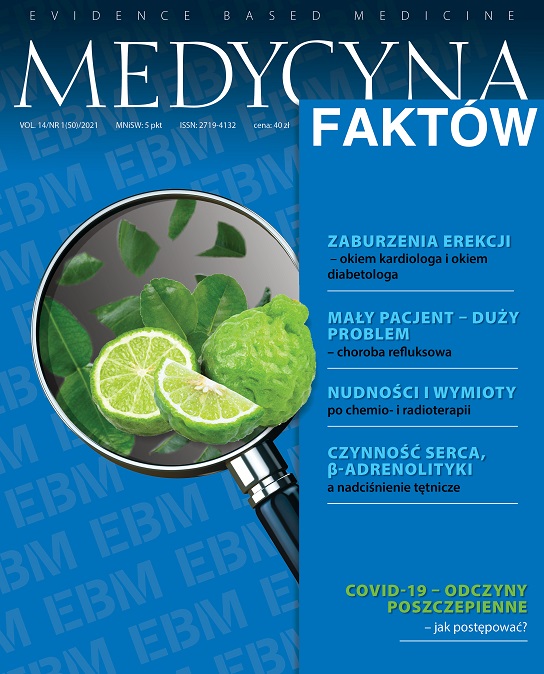Terapia skojarzona mirabegronem z tamsulosyną w leczeniu pęcherza nadaktywnego u mężczyzn z objawami z dolnych dróg moczowych Artykuł przeglądowy
##plugins.themes.bootstrap3.article.main##
Abstrakt
Mężczyznom z objawami z dolnych dróg moczowych (LUTS, lower urinary tract symptoms) leczonym ?-blokerami mogą towarzyszyć symptomy nadaktywnego pęcherza moczowego (OAB, overactive bladder), co wymaga dodatkowego stosowania leków antymuskarynowych. Mirabegron (agonista receptora B3-adrenergicznego) jest alternatywną terapią uzupełniającą, skuteczniejszą od placebo pod względem poprawy objawów OAB i lepiej tolerowaną. Zaobserwowano, że skojarzone leczenie tamsulosyną z mirabegronem wpływa korzystnie na średnią objętość wydalonego moczu, epizodów parć naglących w ciągu doby oraz liczbę mikcji. W przypadku tamsulosyny w skojarzeniu z placebo obserwowano wyższy ogólny odsetek zdarzeń niepożądanych zaistniałych w trakcie leczenia niż w przypadku tamsulosyny z mirabegronem. Wyniki badania PLUS ujawniają przydatność terapii mirabegronem z tamsulosyną w leczeniu mężczyzn z powodu łagodnego powiększenia gruczołu krokowego, u których wystąpiły jednocześnie objawy nadaktywności pęcherza moczowego. Badanie MATCH potwierdziło, że terapia skojarzona przez 12 tygodni u mężczyzn z symptomami LUTS i OAB ma wyższą skuteczność niż placebo i była dobrze tolerowana.
##plugins.themes.bootstrap3.article.details##
Copyright © by Medical Education. All rights reserved.
Bibliografia
2. Drake MJ. Do we need a new definition of the overactive bladder syndrome? ICI-RS 2013. Neurourol Urodyn. 2014; 33(5): 622-4.
3. Coyne KS, Sexton CC, Vats V et al. National community prevalence of overactive bladder in the United States stratified by sex and age. Urology. 2011; 77: 1081.
4. Irwin DE, Kopp ZS, Agatep B et al. Worldwide prevalence estimates of lower urinary tract symptoms, overactive bladder, urinary incontinence and bladder outlet obstruction. BJU Int. 2011; 108: 1132.
5. Chapple CR, Dvorak V, Radziszewski P et al. A phase II dose-ranging study of mirabegron in patients with overactive bladder. Int Urogynecol J. 2013; 24(9): 1447-58.
6. Chapple C. Systematic review of therapy for men with overactive bladder. Can Urol Assoc J. 2011; 5(suppl 2): S143-5.
7. Egan KB. The epidemiology of benign prostatic hyperplasia associated with lower urinary tract symptoms: prevalence and incident rates. Urol Clin North Am. 2016; 43: 289.
8. Fourcade RO, Lacoin F, Roupret M et al. Outcomes and general health-related quality of life among patients medically treated in general daily practice for lower urinary tract symptoms due to benign prostatic hyperplasia. World J Urol. 2012; 30: 419.
9. McVary KT, Roehrborn CG, Avins AL et al. Update on AUA guideline on the management of benign prostatic hyperplasia. J Urol. 2011; 185: 1793.
10. Kaplan SA, Roehrborn CG, Dmochowski R et al. Tolterodine extended release improves over- active bladder symptoms in men with overactive bladder and nocturia. Urology. 2006; 68: 328.
11. Chancellor MB, Zinner N, Whitmore K et al. Efficacy of solifenacin in patients previously treated with tolterodine extended release 4 mg: results of a 12-week, multicenter, open-label, flexible-dose study. Clin Ther. 2008; 30: 1766.
12. van Kerrebroeck P, Chapple C, Drogendijk T et al. Combination therapy with solifenacin and tamsulosin oral controlled absorption system in a single tablet for lower urinary tract symptoms in men: efficacy and safety results from the randomised controlled NEPTUNE trial. Eur Urol. 2013; 64: 1003.
13. Chapple C, Herschorn S, Abrams P et al. Tolterodine treatment improves storage symptoms suggestive of overactive bladder in men treated with a-blockers. Eur Urol. 2009; 56: 534.
14. Chapple CR, Khullar V, Gabriel Z et al. The effects of antimuscarinic treatments in overactive bladder: an update of a systematic review and meta-analysis. Eur Urol. 2008; 54: 543.
15. Kakizaki H, Lee KS, Yamamoto O et al. Mirabegron add-on therapy to tamsulosin for the treatment of overactive bladder in men with lower urinary tract symptoms: a randomized, placebo-controlled study (MATCH). Eur Urol Focus. 2019; 6(4): P729-37.https://doi.org/10.1016/j.euf.2019.10.019.
16. Roehrborn CG. Chapter 103: Benign Prostatic Hyperplasia: Etiology, Pathophysiology, Epidemiology, and Natural History. In: Wein AJ, Kavoussi LR, Partin AW et al (ed). Campbell and Walsh Urology, 11th Edition. Elsevier-Saunders, Philadephia, PA: 2435.
17. Levin RM, Monson FC, Haugaard N et al. Genetic and cellular characteristics of bladder outlet obstruction. Urol Clin North Am. 1995; 22: 263-83.
18. Levin RM, Haugaard N, O?Connor L et al. Obstructive response of human bladder to BPH vs. rabbit bladder response to partial outlet obstruction: a direct comparison. Neurourol Urodyn. 2000; 19: 609-29.
19. Nordling J. The aging bladder ? a significant but underestimated role in the development of lower urinary tract symptoms. Exp Gerontol. 2002; 37: 991-9.
20. Chai TC, Andersson KE, Tuttle JB et al. Altered neural control of micturition in the aged f344 rat. Urol Res. 2000; 28: 348-54.
21. Van Venrooj GE, Van Melick HH, Eckhardt MD et al. Correlations of urodynamic changes with changes in symptoms and well-being after transurethral resection of the prostate. J Urol. 2002; 168: 605-9.
22. Wada N, Iuchi H, Kita M et al. Urodynamic efficacy and safety of mirabegron add-on treatment with tamsulosin for Japanese male patients with overactive bladder. Low Urin Tract Symptoms. 2016; 8: 171-6.
23. Ichihara K, Masumori N, Fukuta F et al. A randomized controlled study of the efficacy of tamsulosin monotherapy and its combination with mirabegron for overactive bladder induced by benign prostatic obstruction. J Urol. 2015; 193: 921-6.
24. Yamaguchi O, Kakizaki H, Homma Y et al. Solifenacin as add-on therapy for overactive bladder symptoms in men treated for lower urinary tract symptoms ? ASSIST, randomized controlled study. Urology. 2011; 78: 126-33.
25. Lee S, Malhotra B, Creanga D et al. A meta-analysis of the placebo response in antimuscarinic drug trials for overactive bladder. BMC Med Res Methodol. 2009; 9: 55.
26. Kaplan SA, McCammon K, Fincher R et al. Safety and tolerability of solifenacin add-on therapy to alpha-blocker treated men with residual urgency and frequency. J Urol. 2009; 182(6): 2825-30.
27. Khullar V, Amarenco G, Angulo JC et al. Efficacy and tolerability of mirabegron, a beta(3)-adrenoceptor agonist, in patients with overactive bladder: results from a randomised European-Australian phase 3 trial. Eur Urol. 2013; 63(2): 283-95.
28. Nitti VW, Auerbach S, Martin N et al. Results of a randomized phase III trial of mirabegron in patients with overactive bladder. J Urol. 2013; 189(4): 1388-95.
